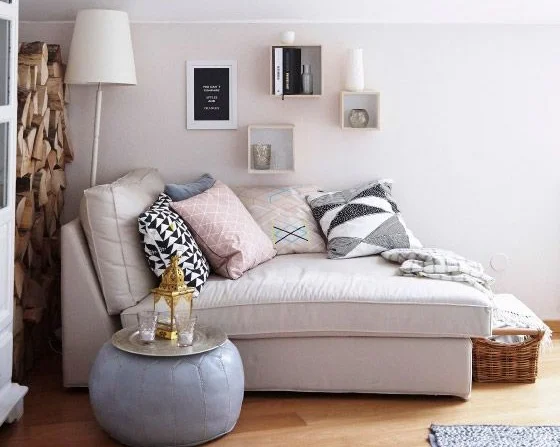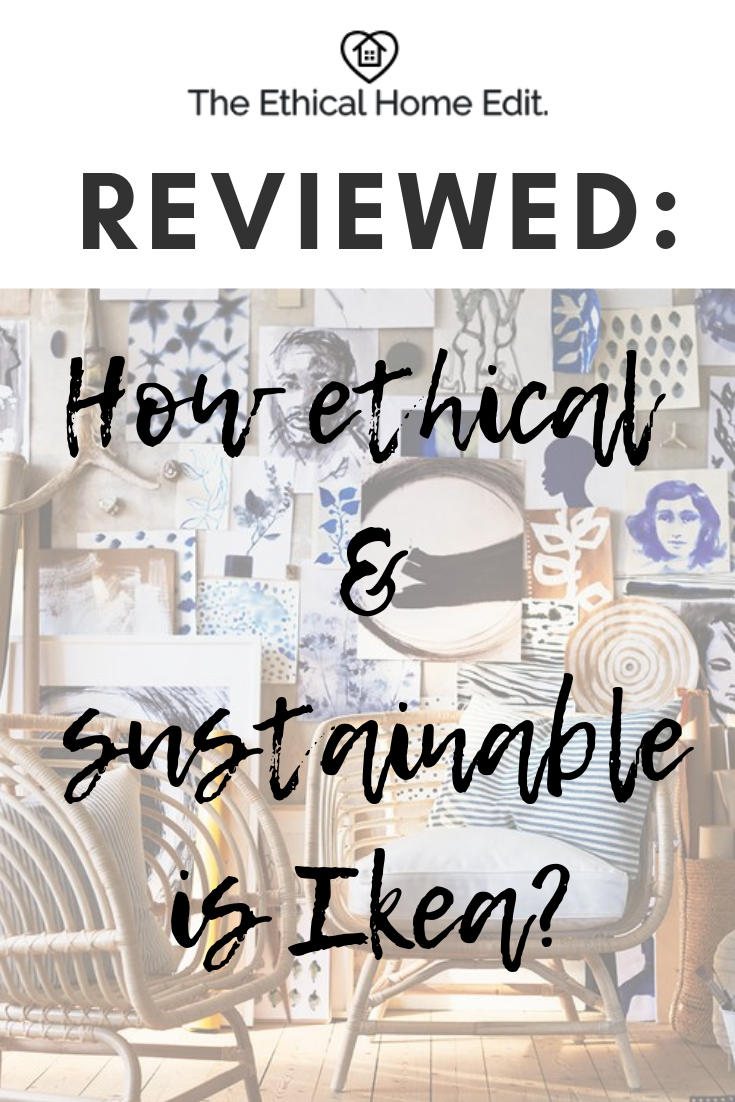Reviewed: How ethical and sustainable is Ikea?
Ethical Home Edit Rating: GOOD
Sustainability: ✮✮✮✮✩
Social empowerment: ✮✮✮✮✩
Animal friendly: ✮✮✩✩✩
Price: $ - $$
Ships to: Worldwide
Intro
The Swedish flat-pack furniture giant IKEA needs no introduction. Ah IKEA. We’ve all been there, picking up tealights and other accessories you didn’t know you needed, being disappointed that the one thing you actually wanted is out of stock, buying yet another blue bag because you left yours at home, and arguing with a loved one over whether or not to cut through the home display set-ups and head directly to the marketplace.
And lest we forget the tiny pencils.
It’s a bit tricky to review IKEA as one entity. IKEA stores are actually operated by the Ingka Group (Ingka) under franchise agreements with Inter-IKEA Systems B.V. Inter-IKEA Systems B.V. owns the IKEA concept and is part of the Inter-IKEA Group who are responsible for IKEA products, systems, design etc.
Ingka operates 367 IKEA stores in over 30 countries that generate over 830 million in-person visits per year and receive 2.35 billion visits to the IKEA.com website. In the 2018 financial year, IKEA generated EUR 34.8 billion in total retail sales. That’s a lot of flat-pack.
It’s also worth noting that Ingka employs over 160,000 people, owns approximately 180,000 hectares of responsibly managed forests, offers home solar energy under the IKEA brand, and has partnerships with 58 social entrepreneurs and social businesses in 14 countries.
People & Planet Positive
IKEA’s sustainability strategy - People & Planet Positive – was launched in 2012, putting IKEA well ahead of the curve in terms of setting out its acknowledgement of its social and environmental responsibilities and in taking steps to reduce its negative impact. So, seven years on from the start of its sustainability journey, how well is IKEA doing?
Like all good sustainability strategies, People & Planet Positive is built around the United Nations’ Sustainable Development Goals (SDGs). The strategy is divided into three focus areas:
Healthy and sustainable living
Circular and climate positive
Fair and equal
I particularly like IKEA’s ambition ‘to inspire and enable more than one billion people to live a better everyday life within the limits of the planet by 2030’. One billion people is a lot. But it just goes to show the impact large corporations can have if they choose to put planet and people on an equal footing to profit.
“We want to have a positive impact on people and the planet. For us it’s about balancing economic growth and positive social impact with environmental protection and regeneration.”
IKEA’S APPROACH TO SUSTAINABILITY
The ‘Planet’ section of IKEA’s sustainability strategy covers a range of commitments relating to plastics, chemicals, water, cotton supply, greenhouse gas emissions (GHGs), wood, energy use and efficiency. There are some lofty commitments to be achieved by 2030, including becoming climate positive by reducing the amount of GHGs than the company emits. However, while there are a lot of big, bold statements, it’s tricky to spot the concrete targets IKEA intends to deliver in the years running up to 2030.
Having said that, IKEA and Ingka both publish an annual report on progress so it will be easy to keep tabs on how well they are doing against their stated aims.
One thing that stands out for me as truly positive, and extremely exciting, is IKEA’s recognition that one of its biggest challenges is unsustainable consumption. IKEA has committed to defining what responsible consumption means for the company and exploring how it can prolong the life of its products and make it easier to buy, fix, sell, share and give products away.
A circular approach
IKEA is working on becoming a circular business, including when it comes to the design of its products. It wants all of its products to have circular capabilities: designed from the very beginning to be repurposed, repaired, reused, resold and recycled. This is a lofty vision, and it will be interesting to see how IKEA develops the concrete steps to make this a reality, particularly the challenge it faces regarding what happens once products leave the store.
To that end, IKEA has been trialling different approaches to help customers repair, reuse and recycle, and give products a second life through reselling. IKEA Retail Japan, for example, offers a buy-back service for IKEA furniture that’s still in good condition but no longer needed. Customers can exchange their unwanted furniture for a voucher to spend in store. The furniture is then refurbished and sold at a reduced rate to a new customer.
I’ve also spotted in Ingka’s report that it is working with the Ellen MacArthur Foundation and the Circular Economy 8 (CE8) on its approach to becoming part of a circular economy. This is great news.
More to do when it comes to cotton
IKEA is working on improving how it sources its cotton as part of its goal of sourcing all raw materials from more sustainable sources by 2020. IKEA has signed the Uzbek Cotton Pledge to avoid the use of cotton made using forced labour in Uzbekistan, and is part of the Better Cotton Initiative (BCI), sourcing at least 75 percent of their cotton as Better Cotton in 2018. That still leaves 25 percent of their cotton sourced elsewhere however, and given the volumes they use, that’s a sizeable environmental impact.
Sustainability rating
I’ve given IKEA a four star rating (good) for its approach to sustainability. It’s doing some pretty amazing things to reduce its negative environmental impacts - significantly more so than many other furniture and home decor brands. However, as it stands, it is pretty hard to reconcile IKEA’s gargantuan size and mass production model with genuine eco-friendliness. I’m watching with keen interest to see how IKEA develops its approach over the coming years.
IKEA’S APPROACH TO SOCIAL EMPOWERMENT
The IKEA Way on purchasing products, materials and services (IWAY) is IKEA’s supplier Code of Conduct. It sets out minimum requirements on environmental, social and working conditions and is based on the Universal Declaration of Human Rights, the United Nations Convention on the Rights of the Child, eight core conventions defined in the ILO Fundamental Principles of Rights at Work, and the Ten Principles of the UN Global Compact. It is clear that IKEA does not permit child labour or forced labour within its supply chain and mandates breaks and time off for workers.
IKEA operates a risk-based approach to its large supply chain, which makes sense given its size, and it audits a number of its direct suppliers. Where suppliers do not meet the standards, an action-plan is agreed to correct any issues. Suppliers and sub-suppliers are phased out if corrective actions are not put in place.
Empowering through employment
One of my favourite things about IKEA’s parent company, Ingka, is a commitment to help people who lack the skills or experience, or face other barriers that make it hard to find or maintain employment, to find work in the retail industry. Ingka is focusing on young people, people with disabilities, people over 50 years old, migrants, refugees and women who have been out of the workplace.
In 2018, Ingka ran projects in 15 countries providing skills development and work experience placements. Its goal is to have skills for employment programmes in all 30 of its markets by 2025, building partnerships in local communities to tackle unemployment, especially for people experiencing poverty and inequalities. This is a laudable approach and one that Ingka should be commended for. I am particularly impressed with its initiatives towards refugee inclusion in IKEA stores in Norway.
IKEA works with social entrepreneurs and actively engages in local communities to be an inclusive business. There isn’t much detailed information online on how IKEA works with local artisans, though I am aware that this is something IKEA does - I’ve bought products in the past that have been co-created with local craftspeople around the world.
Social empowerment rating
I’ve given IKEA a four star (good) rating on its approach to people and social empowerment. There’s more to do to ensure that everyone throughout IKEA’s supply chains receives a fair wage and decent conditions, but IKEA is taking significant steps in leading by example.
IKEA’S APPROACH TO ANIMAL RIGHTS
I’ve had to give IKEA a two star (below average) rating for their animal friendliness as I have struggled to find much information at all on its approach to our furry and feathered friends.
I was able to find that IKEA has begun a journey to transform all the wool it uses in its products to 100 percent responsibly sourced wool. It says it will do this by sourcing wool which follows the ‘Responsible Wool Standard’ (RWS) guideline, meaning that the wool comes from sheep that are treated with respect, and the land where they eat and rest is managed responsibly.
This is a good start, but given that IKEA also uses feathers and leather in its products (I’m not sure about fur), I would expect to see more information about the sourcing of these products on its website.
CONCLUSION
IKEA’s overall rating is GOOD.
IKEA is demonstrating good leadership overall in its approach to sustainability and ethics in the home decor and furniture industry. If it meets the ambitious targets it has set itself, it will be an outstanding place for conscious consumers to shop by 2030. It’s main drawbacks right now are its lack of transparency when it comes to animal welfare and it’s gargantuan size. Until IKEA is able to put in place its circular business vision, it’s negative overall impact resulting from the large volume of products it is producing is likely to undermine the environmental and social progress it is making elsewhere.


